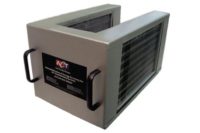In the case of GlaxoSmithKline, HPT’s passive energy recovery and dehumidification systems were installed on an HVAC system serving a 225,000-square-foot plant with a 1,000-ton chilled water loop and a 400-ton chiller. A processing area within the plant requires a maximum relative humidity of 50 percent at 72°F. To maintain that humidity level, GlaxoSmithKline must extract an extraordinary amount of moisture from the ambient air, which was initially accomplished by lowering the temperature of the chiller loop to a setpoint of 39°. Additional dehumidification was obtained by overcooling the supply air and then reheating it, a very energy-intensive process. With Heat Pipe Technology, GlaxoSmithKline was able to raise the chiller loop setpoint, saving the company $26,000 per year in energy costs. The direct CO2 reduction is estimated at 65 metric tonnes, per year, with direct and indirect CO2 reduction of 164 metric tonnes. GlaxoSmithKline estimated that direct payback of the Heat Pipe Technology system was just 1.6 years.
In the case of the optical lens maker, the manufacturing process required an extraordinarily low 40 percent relative humidity. With the HPT installation, the company was able to reduce its chilled water requirements by 11 tonnes, at a savings of $8,000 per year. The company also saw a “reheat phase” energy reduction of 15 percent, for a $20,000 per year savings. The combined $28,000 savings is enough to pay back the Heat Pipe Technology installation within one year, to say nothing of ongoing savings of $28,000 per year.
“Heat pipe technology can bring dramatic savings to a wide range of HVAC systems, not just to commercial manufacturing,” said HPT’s senior vice president of sales and marketing, Mazen Awad. “If you suspect you are spending too much on energy to condition the air in your building or plant, Heat Pipe Technology has energy modeling software that can illustrate our potential savings, so you can examine a heat pipe implementation virtually with a high degree of confidence for its success.”
For more information, visit www.heatpipe.com.
Publication date: 03/05/2012






